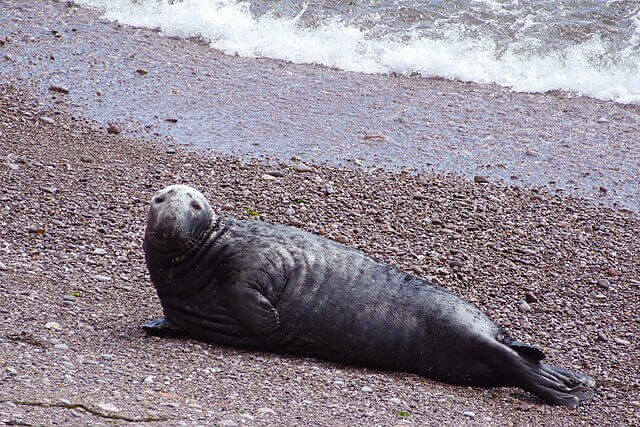
Grey seals make a remarkable comeback in the UK.
The once-heavily hunted mammal is now appearing in record numbers throughout the UK, and they have been observed in some unlikely locations.
In the UK, there are a lot of grey seals. In recent weeks, pups have been rescued from outside kebab shops, fish and chip restaurants, and farmers’ fields after nearly disappearing a century ago.
Environmentalists claim that it is a remarkable conservation success story. Because seals were frequently regarded as pests in fishing communities, numbers fell as low as 500 at the beginning of the 20th century as a result of hunting. About 40% of the world’s grey seals live in the UK, which is home to approximately 120,000 of them. They are now more common than the common seal, also known as the harbour seal, which is the main seal species in the UK.
The British Isles are the ideal habitat for the large marine mammals because they lack predators and have abundant fishing waters, with the occasional killer whale.
Grey seals, which live between 30 and 40 years, can be seen all year long. However, during the breeding season, tourists flock to beaches every winter to watch them with their young, who lie on the sand waiting for their food to break down between fishing trips. The fluffy pups stay put as they grow in size until they no longer have a white coat and can swim alone in the North Sea and Atlantic Ocean. This season, the majority have already left their colonies.
On the Norfolk coast, the chair of Friends of Horsey Seals, Peter Ansell, has witnessed the grey seal’s resurgence firsthand. For the past 18 years, the former manager of a truck park has assisted in the care of a colony on a five-mile stretch between Waxham and Winterton. Nearly 4,000 pups were born this year, almost double the number of pups born in the winter of 2019-2020, the last time they were counted.
“When I first started, there were less than 100 pups born. It’s been rising steadily. There’s been more and more. When we got to 1,000, we thought, ‘bloody hell!’ … now we’re getting a bit blase,” he says.
During the pupping season, volunteers like Ansell make sure that people stay away from the seals and run an emergency line for when young seals get into trouble.
“The pups do tend to wander a long way,” he says, recalling the rescue of a seal from outside a fish and chip shop this month, around the time another was spotted outside a nearby kebab shop on the Norfolk coast.
“It just shows what a varied diet they have! Some of them are nice big fat ones that weigh up to 45kg. It’s a long walk with them if you’ve got to stretcher them to the car. One lady found a pup in her back garden. When we got there, it was behind the side gate. He was a big one, too. They really get in a surprising number of places,” he says.
According to marine officer Lara Howe, who works for the Manx Wildlife Trust on the Isle of Man, the public is widely applauding seals “hauling out” in new locations as their numbers rise.
“They’re very charismatic animals. People really have a strong affection for them. We see that all the time: people calling us up and reporting them on the beach. People love to watch them. I think it’s one of those things you remember from being a child. We’ve even got some fishermen who feed the friendly ones in the harbour,” she says.
“We’ve had pups go up the slipway on the beach and try to head to the pub. Ours like to try to go for a pint!” says Howe.
As the mammals have been officially protected by UK law since 1970, Georgia de Jong Cleyndert, head of marine at the Cumbria Wildlife Trust, claims that the end of human hunting pressures was a major factor in the return.
“We have removed that hunting pressure and they have bounced back,” she says. “Further research is needed but we think the seals might be using the artificial reefs on the windfarms to forage.
“There’s been a huge increase in the population. A couple of years ago, we recorded 518 seals hauled out and the area has become an established breeding colony. It’s a real success story.”
——————————————————————————
At Natural World Fund, we are passionate about stopping the decline in our wildlife.
The declines in our wildlife is shocking and frightening. Without much more support, many of the animals we know and love will continue in their declines towards extinction.
When you help to restore a patch of degraded land through rewilding to forests, meadows, or wetlands, you have a massive impact on the biodiversity at a local level. You give animals a home and food that they otherwise would not have had, and it has a positive snowball effect for the food chain.
We are convinced that this is much better for the UK than growing lots of fast-growing coniferous trees, solely to remove carbon, that don’t actually help our animals to thrive.
This is why we stand for restoring nature in the UK through responsible rewilding. For us, it is the right thing to do. Let’s do what’s right for nature!
Support our work today at https://naturalworldfund.com/ and join in the solution!

